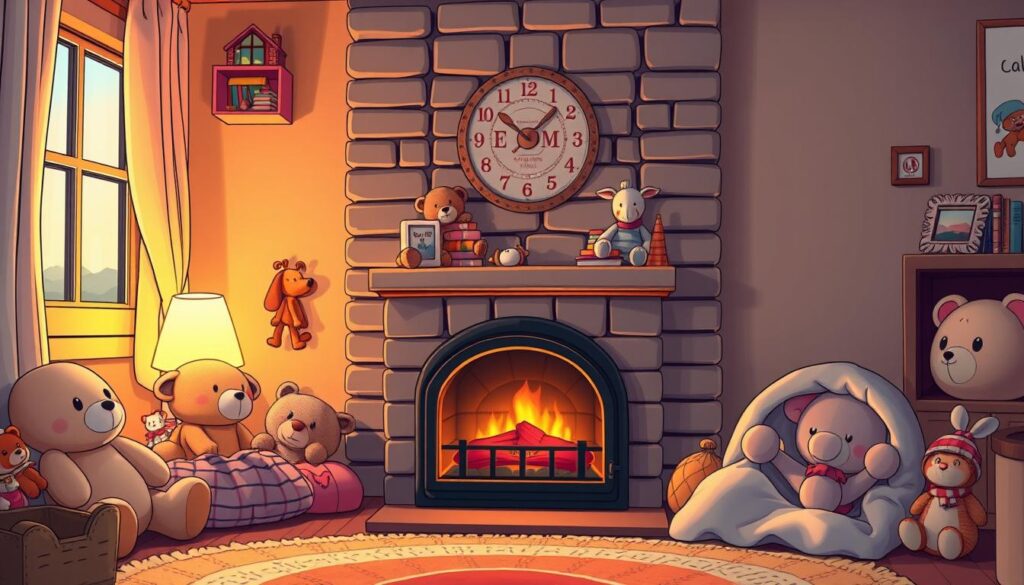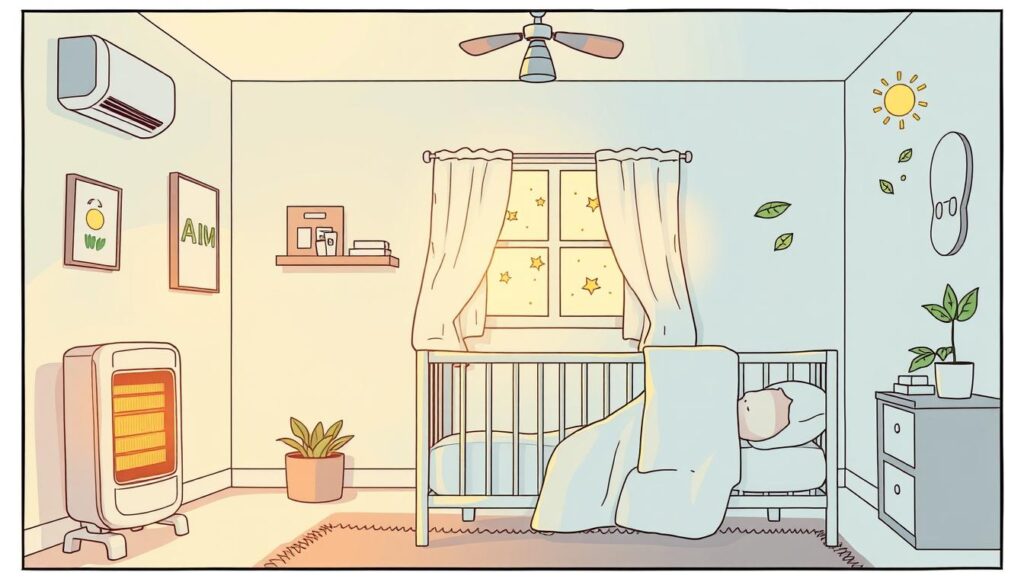How to Choose Safe Space Heaters for Baby’s Room
As the winter chill settles in, keeping your baby’s room cozy and warm becomes a top priority for parents. However, the use of space heaters near infants requires utmost caution. Did you know that over 400 Americans die each year from unintentional carbon monoxide (CO) poisoning, with many incidents involving space heaters? With safety as the primary concern, this guide will help you navigate the process of selecting the right space heater for your baby’s nursery.
Key Takeaways
- Prioritize safety features like automatic shut-off and cool-touch exteriors when choosing a space heater for your baby’s room.
- Maintain a comfortable temperature range of 68-70°F (20-21°C) to support your infant’s health and development.
- Ensure proper placement and ventilation to prevent carbon monoxide buildup and other fire hazards.
- Consider energy-efficient solutions to keep heating costs manageable during the winter months.
- Stay vigilant and follow manufacturer guidelines to create a warm, secure environment for your little one.
Understanding the Importance of Temperature Control in Baby’s Room
Maintaining the proper temperature in your baby’s room is crucial for their comfort, health, and overall well-being. The ideal temperature range for infant sleep is between 68-72°F (20-22°C). Keeping the room within this range helps prevent overheating, which can increase the risk of Sudden Infant Death Syndrome (SIDS), as well as hypothermia, which can lead to various health issues.
Optimal Temperature Range for Infant Sleep
The recommended temperature range for a baby’s room is between 68-72°F (20-22°C). This temperature range is considered the most comfortable and safe for infant sleep. Temperatures outside of this range can disrupt a baby’s sleep patterns and contribute to potential health problems.
Effects of Room Temperature on Baby’s Health
Overheating can increase the risk of SIDS, while too-cold temperatures may lead to hypothermia and other health concerns. Maintaining the proper room temperature is essential for supporting a baby’s natural temperature regulation and preventing any adverse effects on their well-being.
Seasonal Temperature Considerations
Seasonal changes in temperature require adjustments to the baby’s room. During the colder months, extra layers, such as warm clothing and blankets, may be necessary to keep the baby comfortable. Conversely, in warmer seasons, lightweight clothing and proper ventilation are crucial to prevent overheating. Monitoring and adapting the room temperature based on the weather is key to ensuring a safe and comfortable environment for your baby.
| Season | Recommended Temperature Range | Potential Risks |
|---|---|---|
| Winter | 68-72°F (20-22°C) | Hypothermia |
| Summer | 68-72°F (20-22°C) | Overheating, SIDS |
Proper temperature control in your baby’s room supports better sleep quality, reduces the risk of health issues, and contributes to their overall well-being. Staying vigilant about maintaining the ideal temperature range is an essential aspect of creating a safe and comfortable environment for your little one.
Types of Space Heaters Suitable for Nurseries
When selecting a space heater for your baby’s room, it’s crucial to prioritize safety and energy efficiency. Among the suitable options, consider oil-filled radiators, ceramic heaters, or infrared heaters. These types of space heaters are generally regarded as safer and more energy-efficient choices for nurseries.
Oil-filled radiators provide consistent, even heating without the use of a fan, making them a great option for maintaining a comfortable temperature in your little one’s room. Ceramic heaters, on the other hand, offer quick and efficient warming, making them a practical choice for short-term heating needs. Infrared heaters are also an energy-efficient option, as they transfer heat directly to objects and people rather than heating the air, which can often lead to dryness.
It’s important to avoid open-coil or radiant heaters in nurseries due to the increased risk of burns. Always prioritize models with safety certifications from recognized organizations to ensure the highest level of protection for your child.
- Oil-filled radiators provide consistent, fan-free heating
- Ceramic heaters offer quick and efficient warming
- Infrared heaters are energy-efficient and don’t dry out the air
- Avoid open-coil or radiant heaters due to burn risks
- Choose models with safety certifications from recognized organizations
By carefully selecting the right type of space heater for your nursery, you can create a cozy and safe environment for your little one to rest and thrive.
Safety Features to Look for in Baby Room Heaters
When selecting a space heater for your baby’s room, prioritizing safety features is crucial. From automatic shut-off mechanisms to cool-touch exteriors, these essential elements can make all the difference in maintaining a secure environment for your little one.
Auto Shut-off Mechanisms
Look for space heaters equipped with robust auto shut-off features that automatically turn the unit off when it reaches a certain temperature or tips over. This safeguard helps prevent overheating and potential fire hazards, ensuring your baby’s safety at all times.
Cool-Touch Exteriors
Babies and toddlers are naturally curious, and accidentally touching a hot surface can lead to painful burns. Choose a space heater with a cool-touch exterior, which remains safe to the touch even during operation, minimizing the risk of accidental injury.
Tip-Over Protection Systems
Tip-over protection is another essential safety feature to look for in a baby room heater. These systems instantly shut off the power when the unit is knocked over, preventing fires and other potential dangers.
Additionally, consider features like adjustable thermostats, overheat protection, and GFCI plugs for added safety and peace of mind when heating your baby’s room. By prioritizing these essential safety elements, you can create a warm, cozy, and secure environment for your little one to thrive.
| Safety Feature | Importance | Example Products |
|---|---|---|
| Auto Shut-off Mechanisms | Prevents overheating and fire hazards | Lasko Ceramic Heater, Honeywell Safety Shut-off Heater |
| Cool-Touch Exteriors | Protects against accidental burns | Vornado Vortex Heater, Dyson Pure Hot+Cool Link |
| Tip-Over Protection Systems | Ensures power shut-off if knocked over | Holmes Oscillating Heater, Lifesmart Infrared Heater |

Maintaining Warmth Safely: Essential Guidelines
When it comes to creating a cozy and secure environment for your baby’s room, maintaining warmth safely is of utmost importance. By following a few essential guidelines, you can ensure your little one stays comfortable and protected from potential hazards.
To maintain warmth safely, proper insulation is key. Invest in high-quality insulation materials to prevent heat loss and minimize drafts. Use draft stoppers for windows and doors, and consider blackout curtains to add an extra layer of insulation.
- Ensure the room is well-ventilated to prevent moisture buildup, which can compromise air quality and lead to potential health concerns.
- Regularly check and clean heating vents to guarantee efficient heat distribution and prevent dust accumulation.
When it comes to heating sources, it’s essential to exercise caution. Never use electric blankets or hot water bottles in a baby’s crib, as these can pose serious safety risks. Instead, focus on creating a cozy, well-insulated environment that maintains a comfortable temperature without the need for direct heating.
| Insulation Tip | Benefit |
|---|---|
| Use Draft Stoppers | Prevent heat loss and drafts |
| Install Blackout Curtains | Provide an extra layer of insulation |
| Regularly Check and Clean Heating Vents | Ensure efficient heat distribution and prevent dust buildup |
By following these essential guidelines, you can maintain warmth safely and create a cozy, comfortable environment for your baby’s room, ensuring their well-being and promoting a good night’s sleep.
Proper Placement of Space Heaters in Baby’s Room
When it comes to keeping your baby’s room warm and cozy, the proper placement of space heaters is crucial. Space heaters can be a great solution, but they require careful consideration to ensure the safety of your little one.
Safe Distance Requirements
To prevent potential hazards, it’s recommended to keep space heaters at least 3 feet away from anything that can burn, such as cribs, furniture, curtains, and bedding. This distance helps to minimize the risk of accidental fires or burns.
Avoiding Hazardous Locations
Avoid placing space heaters in damp areas or near water sources, as this can increase the risk of electrical hazards. Additionally, it’s important to keep heaters away from walkways to prevent tripping and falling accidents.
Cord Management Tips
Proper cord management is essential when using space heaters in a baby’s room. Secure the cords to the wall or floor to prevent entanglement risks, and never run them under carpets or rugs. Always plug the heater directly into a wall outlet, rather than using extension cords or power strips, to reduce fire hazards.
By following these guidelines for the proper placement of space heaters, you can create a warm, safe, and comfortable environment for your baby to thrive.
Energy Efficiency and Cost Considerations
When choosing a space heater for your baby’s room, energy efficiency is a crucial factor to consider. Look for Energy Star certified heaters, which are designed to maximize energy savings while maintaining optimal performance. These models are engineered to heat the space efficiently, reducing your energy consumption and utility bills.
To further enhance energy efficiency, incorporate the use of programmable thermostats. These advanced devices allow you to regulate the temperature in the nursery, ensuring the room stays within the ideal comfort range while minimizing unnecessary heating when the baby is not present.
- Seal windows and doors to prevent heat loss and drafts, which can compromise the heating system’s effectiveness.
- Consider zoned heating strategies, focusing the warmth specifically in the baby’s room rather than heating the entire home.
- Regularly maintain your heating system to ensure it operates at peak efficiency, further reducing energy costs.
- Utilize natural sunlight during the day to supplement the heating, minimizing the need for artificial heat sources.
By implementing these energy efficiency measures, you can significantly reduce the running costs of your space heater while maintaining a comfortable and safe environment for your baby. These simple steps can lead to substantial savings on your energy bills, making your home more eco-friendly and cost-effective.

Carbon Monoxide Safety and Detection
Carbon monoxide (CO) is a silent, odorless killer that can pose a serious threat to your family’s safety, especially in your baby’s room. To protect your little one, it’s crucial to install and maintain CO detectors throughout your home, especially near sleeping areas.
Installing and Maintaining CO Detectors
Place CO detectors on every level of your home, ensuring they are positioned within 15 feet of each bedroom door. Replace the batteries annually and test the detectors monthly to ensure they are functioning properly. Proper maintenance is essential to keeping your family safe from this invisible danger.
Warning Signs of CO Presence
Be aware of the symptoms of carbon monoxide poisoning, which include headache, dizziness, nausea, and confusion. If your CO alarm sounds, immediately evacuate the premises and call emergency services. Never ignore a CO alarm, as it could be the only warning sign of a potentially life-threatening situation.
Regularly maintain your home’s fuel-burning appliances, such as your furnace, water heater, and stove, to prevent the buildup of this deadly gas. Ensure your home is properly ventilated, and never use space heaters or other combustible devices indoors without adequate airflow. Taking these precautions can help keep your baby’s room safe and prevent the devastating consequences of carbon monoxide exposure.
| Statistic | Value |
|---|---|
| Annual deaths from unintentional CO poisoning | More than 400 |
| Annual emergency room visits due to unintentional CO poisoning | Over 100,000 |
| Annual hospitalizations due to unintentional CO poisoning | Over 14,000 |
Alternative Warming Solutions for Baby’s Room
While space heaters can provide targeted warmth for your baby’s room, there are several alternative solutions that can help maintain a cozy and comfortable environment. Focusing on insulation tips, draft prevention, and energy efficiency can make a significant difference in keeping the nursery snug and secure.
Layered Clothing and Sleep Sacks: Dressing your baby in warm, layered clothing and using a cozy sleep sack can be an effective way to retain body heat without relying solely on a space heater. This approach helps regulate your infant’s temperature without the potential safety risks associated with portable heaters.
Insulation and Weatherstripping: Ensuring proper insulation and sealing any drafts in the baby’s room can go a long way in maintaining a comfortable temperature. Investing in thick curtains or cellular shades can also help retain heat and prevent it from escaping through windows.
For a more consistent and energy-efficient heating solution, you may consider radiant floor heating. This system provides gentle, even warmth throughout the room, eliminating the need for standalone space heaters. Additionally, humidifiers can make the air feel warmer without actually increasing the temperature, creating a more comfortable environment for your little one.
By exploring these alternative warming options, you can maintain a cozy and safe nursery for your baby while prioritizing energy efficiency and environmental considerations.
| Alternative Warming Solution | Benefits |
|---|---|
| Layered Clothing and Sleep Sacks | Retains body heat, eliminates safety risks of space heaters |
| Insulation and Weatherstripping | Prevents heat loss, improves energy efficiency |
| Radiant Floor Heating | Provides consistent, energy-efficient warmth |
| Humidifiers | Makes the air feel warmer without increasing temperature |
Common Space Heater Hazards to Avoid
As winter approaches, space heaters can be a valuable tool for keeping your baby’s room cozy and comfortable. However, these devices also come with inherent risks that require diligent attention. To ensure the safety of your little one, it’s crucial to be aware of the common hazards associated with space heaters and take proactive measures to mitigate them.
Electrical Safety Concerns
One of the primary dangers with space heaters is the potential for electrical issues. Overloading electrical circuits by running multiple high-wattage appliances, including space heaters, can lead to dangerous overheating and even fires. Never leave space heaters unattended or running while sleeping, as this drastically increases the risk of accidents. Additionally, it’s essential to avoid using space heaters with damaged cords or plugs, as they can compromise the electrical safety of the device.
Fire Prevention Measures
Space heaters can be a significant fire hazard if not used with extreme caution. Keep all flammable materials, such as curtains, bedding, and toys, at least 3 feet away from the heater. Avoid using extension cords or power strips with space heaters, as they can easily overload and spark a fire. To further enhance fire safety, install smoke detectors in and near the nursery and create a fire escape plan that includes your baby’s room.
By being mindful of these common space heater hazards and taking the necessary precautions, you can help ensure a warm and safe environment for your baby this winter. Remember, the safety of your little one should always be the top priority.
Seasonal Maintenance and Cleaning Tips
As the winter season approaches, it’s crucial to ensure your home is well-prepared for the colder months. Regular furnace maintenance and cleaning can significantly improve energy efficiency and reduce safety risks in your baby’s room. Start by cleaning or replacing furnace filters monthly during the heating season to maintain optimal airflow and indoor air quality.
Additionally, schedule an annual professional HVAC inspection to identify any potential issues and ensure your system is running at peak performance. Don’t forget to clean your space heaters regularly, removing any dust or debris that may have accumulated to prevent fire hazards. If you use a fireplace, be sure to clean and inspect the chimney flue before the first use of the season.
Lastly, take the time to inspect weatherstripping and caulking around windows and doors, sealing any gaps to minimize heat loss and improve insulation. Clean and test your smoke and carbon monoxide detectors to ensure they are functioning properly, safeguarding your family’s well-being. By following these seasonal maintenance and cleaning tips, you can maintain a warm, energy-efficient, and safe environment for your baby’s room throughout the winter.







